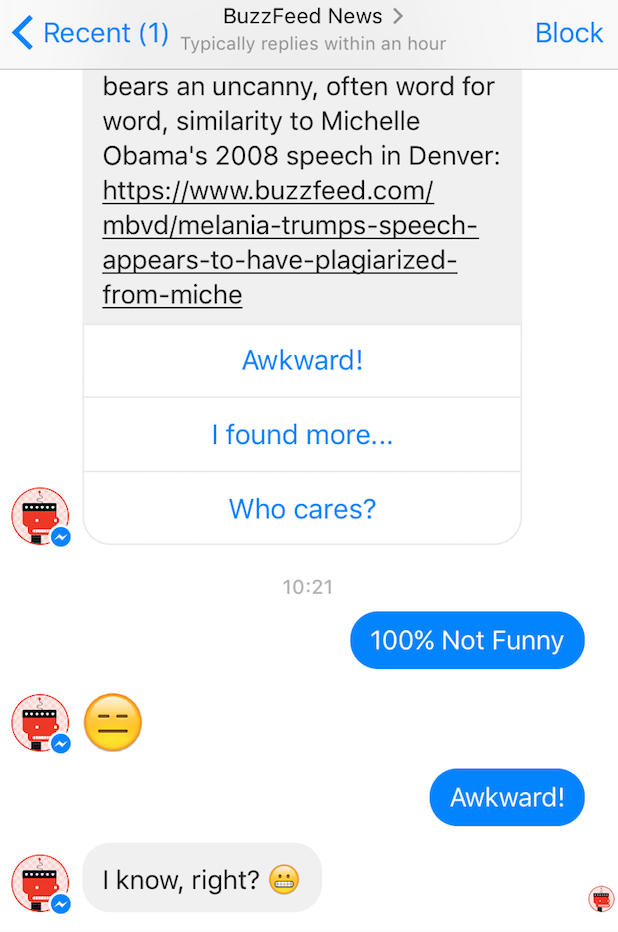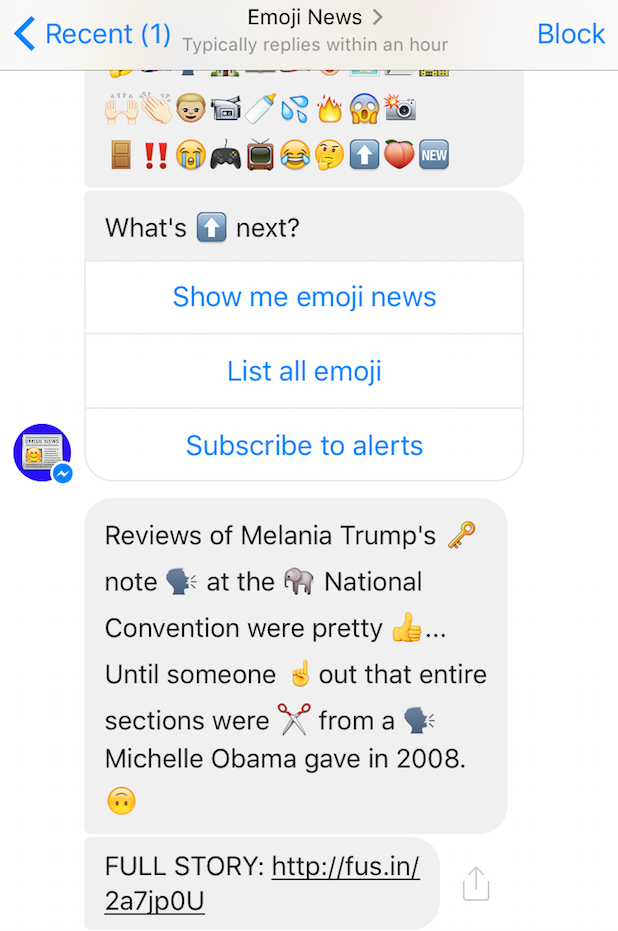
At the beginning of July, Facebook announced new updates to its Messenger platform, which has become very popular with businesses since it was made available to developers in April – more than 11,000 bots have been built by companies, including news organisations, in the last few months.
Facebook Messenger’s new features for bots include support for up to five actions, eliminating the need for people to remember text commands, as well as support for more content types, such as gifs, audio and video, which will play natively in Messenger.
However, Messenger is not the only chat platform out there with bot-building capabilities – other options popular among news organisations include Kik, Telegram and Slack.
So while publishers figure out which of these platforms, if any, they should develop bots for, here is a look at some automated channels news outlets have already released and the conversations they are trying to have with their audiences.
CNN
CNN's Facebook Messenger bot was one of the early-birds, as the organisation had it ready for launch at Facebook's F8 developer conference in April.
CNN’s bot sends one push alert per day, a two-part notification that gives users the latest headlines, followed by short summaries of articles and links to each story.
At the end of June, to draw attention to World Refugee Day, the bot told the story of a day in the life of a refugee family. Readers could also opt out of the particular narrative by choosing to learn facts about refugees around the world instead.
It's world refugee day. We're sharing a day in the life of a refugee family on FB Messenger https://t.co/7oetVwD80e pic.twitter.com/nm1RsL131D
— Masuma Ahuja (@masumaahuja) June 20, 2016
"We curate, you query, that's the idea. We look at the CNN stories from around the globe and publish those according to the time of day and the type of audience we're trying to reach," Alex Wellen, chief product officer at CNN, told Journalism.co.uk back in April.
"Chat bots need to feel more like a chat and less like a bot and get to a place where we understand you, where you are and what you're doing, without you having to share that information and return a response that makes more sense."
CNN also launched a bot on Kik yesterday (18 July) to cover the Republican and Democratic conventions in the US, which are taking place between 18-21 July and 25-28 July.
The Wall Street Journal
The Journal was also one of Messenger's launch partners in April, delivering updates about top stories, breaking news alerts and market moves.
The WSJ bot does not offer many interaction options, aside from viewing full stories and the ability to subscribe and unsubscribe from certain notifications, such as breaking news or a particular aspect of its markets coverage.
The Washington Post
The Post went live with its Messenger bot earlier this week. Joey Marburger, the outlet's head of product, told Nieman Lab the team did not jump on the bot bandwagon straight away because they wanted to wait and study how people reacted to other publishers' bots.
As a result, the Washington Post bot does not send any alerts to users currently, unless they specifically request it.
When people first start chatting to it, the bot asks if they would like to be sent election-night results for the US Presidential, House and Senate races based on their zipcode. After, it offers users the option to read the day's top stories or ask for news on a specific topic, with further personalised features still in development.
BBC World Service
The BBC launched a bot on Telegram for its audience in Uzbekistan, as the broadcaster's online presence in the country, bbcuzbek.com, is blocked.
The Telegram bot sends users a daily digest of articles, allows them to manage what kind of news they receive, and sends them the latest stories.
BBC World Service is also building a Facebook Messenger bot for another one of its languages services, BBC Mundo, for Spanish-speaking audiences who might not visit the site and prefer to get their news on this platform instead.
BuzzFeed
The Republican convention in the US was also the launch pad for BuzzFeed's BuzzBot, released last Sunday and developed by BuzzFeed's Open Lab for Technology and the Arts.
BuzzBot kicks off the conversation by asking users if they are following the convention at all, and whether they are doing so from home or from Cleveland, where the event is held.

All the interactions that follow are based on key moments from the convention. Throughout the chat with the bot, users are asked for input: reacting to a story with an emoji or telling BuzzBot if they thought the situation surrounding the similarities between Melania Trump's and Michelle Obama's speeches was 'awkward' or 'who cares?'.
Fusion
Rather than incorporating emojis in replies and action buttons for users, Fusion went all in and created the Emoji News bot.
The Messenger bot does exactly what is says on the tin, delivering news summaries by replacing key words with emojis, accompanied by links to the full stories on the site.

Users can also tap 'list all emoji' to see all the emojis programmed into the bot and message the bot back with one of the available emojis to ask for stories related to that symbol. There is also an option to subscribe to Emoji News, and the bot will send updates every evening at 9pm.
Yahoo News
The Yahoo News bot tells users about trending stories and sends push alerts about news twice a day, similar to the CNN bot.
After it provides the headlines for top stories, the interactions options the bot makes available for each piece include asking for a summary of that article, reading other stories related to that topic, or viewing a gallery of images the bot automatically pulls from the article.
TechCrunch
TechCrunch's bot, developed in partnership with Chatfuel for both Messenger and Telegram, sends a digest of trending stories once a day. Users can ask for stories by entering keywords manually, such as 'Facebook', and they can also subscribe to receive updates about a particular topic, or from a particular author or section of the site.
The bot aims for a personalised news experience throughout, so if users are also regular visitors of techcrunch.com and they read about certain topics more often, the bot will use that data to serve relevant stories. Occasional TechCrunch readers will receive top stories of the day if no data is available about their behaviour on the site.
Other bots developed by news outlets include: Mic's two Kik bots, TrumpChat and DisorDat Bot; the Guardian's Sous-Chef Messenger bot that provides users with recipes from the Guardian and Observer archives and lets people search for recipes by ingredient; and the Huffington Post's Felix bot on Facebook Messenger, a recommendation engine for programmes to watch on Netflix.
Do you use any bots to get your daily fix of news? Let us know on Twitter @journalismnews, and tell us if we missed any news bots and we will include them in a future update.
Free daily newsletter
If you like our news and feature articles, you can sign up to receive our free daily (Mon-Fri) email newsletter (mobile friendly).
Related articles
- What does it take to do service journalism during the war in Ukraine?
- Get the latest news and jobs from Journalism.co.uk on Telegram
- Weekly journalism news update: artificial intelligence, podcast ad revenue and 'audience canvas'
- How to set up Facebook Messenger chatbots for news updates
- What happens when bots become editors?









